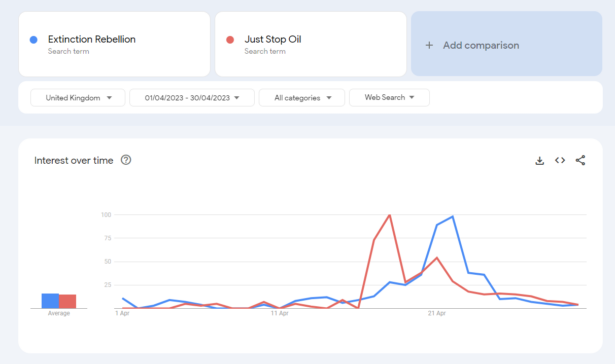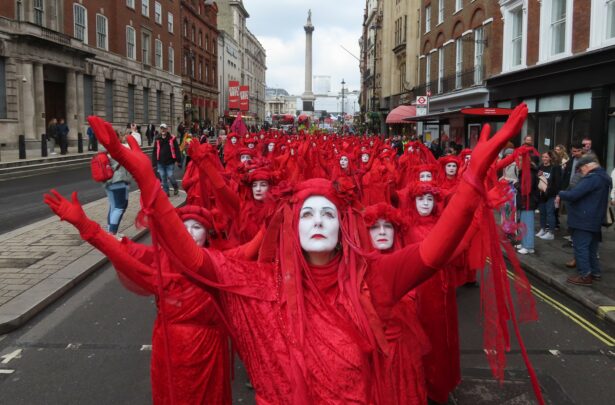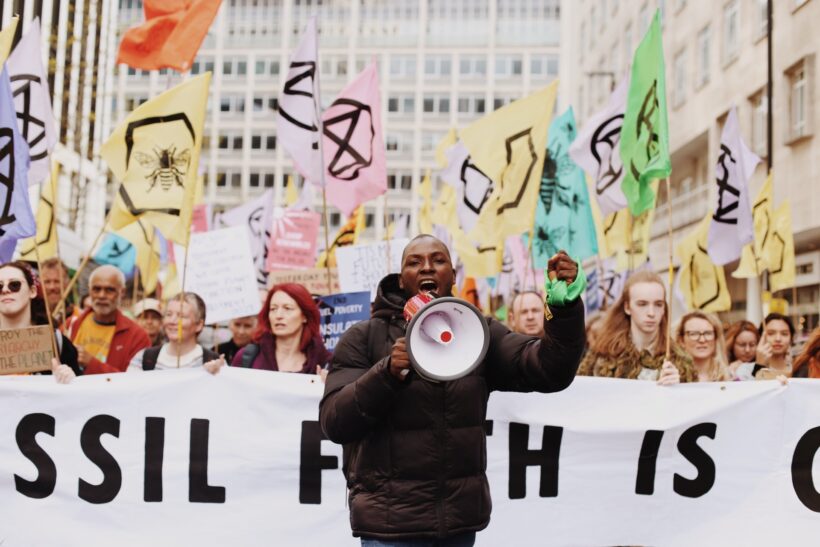The British climate movement’s ‘Big One’ brought out record numbers, but ran into a wall of silence. XR’s new strategy could turn this setback into a new lease on life.
By Douglas Rogers
It’s been just over a month since 60,000 people gathered in London for Extinction Rebellion U.K.’s Big One. Despite being potentially the biggest climate demonstration in U.K. history, you might well have missed it. The press coverage was virtually non-existent and the event produced no noticeable change: The British government remains hell-bent on ecocide, its legislation increasingly draconian, its litany of scandals unrelenting.
Despite this silence — or, indeed, because of it — April 2023 could go down in history as a crucial moment for the U.K. climate movement. And one month on, XR U.K.’s big strategy reveals shows why.
XR’s large-scale London actions have always left behind contested narratives. Whether it’s the miracle of April 2019’s breakthrough, the missteps of October 2019, or the varied post-pandemic efforts at revival: Picking apart the movement’s highs and lows is a pastime relished by many insiders and no shortage of observers.
The Big One has broken this tradition. The narrative within the movement — and even beyond it — seems virtually unanimous.
First off, there’s broad agreement on the numbers: The weekend’s high point, a march around Westminster, seems to have involved somewhere between 60,000 and 90,000 people — numbers, in any case, so massive as to stretch the credibility of counting. If turnover across the four days of proceedings is accounted for, it’s very plausible that XR met its ambitious target of getting 100,000 people on the streets. The Big One’s bigness is beyond question.
The qualitative standpoint is just as straightforward: Attendees overwhelmingly described a positive, festival-meets-fairground atmosphere. Abingdon Street, directly adjacent to Parliament, was peacefully reclaimed from traffic and became a hub for speeches, music, and discussion within and between members of the 200 organizations that turned out in support (prominent names including Greenpeace, Friends of the Earth and a major union).
The relaxed environment meant many with security concerns — parents with families, people with disabilities, first-time protesters, and groups historically oppressed by police — could participate with much more ease than usual.
Big and bad
All this affability came at a price, however: The Met police went easy on the understanding that XR had temporarily sworn off public disruption. No lock-on, no glue, no cunning plans.
This new approach had made waves on its announcement in January, provocatively framed as “We Quit.” But behind the bombast was a sober calculation: that by playing into the newly constrictive limitations demanded by Parliament and the tabloid press, the movement could find greater numbers, less outrage, and ultimately more impact.
People did show up in record numbers for the U.K. climate movement — and this new spirit of cooperation within the wider ecological space could have profound consequences. But on a more immediate level, the lack of impact was astonishing: Press interest was virtually non-existent, to say nothing of the non-response from government or other institutions. As one XR spokesperson pointed out, even The Guardian barely took an interest.
This decisive moment for the long-running “disrupt or don’t disrupt” debate found even clearer focus with framing from Just Stop Oil. A few days prior to The Big One, a Just Stop Oil protester had disrupted the Snooker World Championship: Data from Google Trends shows that this one person’s success garnered comparable interest to what 100,000 people would achieve without disruption on the weekend.

If anything, this sample understates the difference between these two actions: News outlets and social media users appeared to take far more interest in the Just Stop Oil effort. Nor was it all outrage. Plenty of social media commentary was sympathetic — and among the less enthused was none other than the Prime Minister (tellingly, this was to give The Sun‘s conservative readership assurances that he’s on top of things).
The upsides of disruption only got clearer in the week after The Big One, as about 200 Just Stop Oil supporters held slow marches through London, driving weeks of public conversation over fossil fuels — and, increasingly, about democratic rights.
In case this picture wasn’t clear enough, more recently the British media has been flooded with stories about Extinction Rebellion — thanks to an action in The Netherlands, in which 6,000 people blocked a major road.
None of which is to suggest that disruptive protest is somehow innately better than its counterpart. Concerns will doubtless linger over whether/when disruption “alienates” (though this problem is likely overstated). In any case, there’s clearly more to social change than news stories, and XR’s slow alliance-building could see big payoffs in the long term.
But whereas 2022 saw fierce debates within XR U.K. over whether to continue centering nonviolent direct action — to the extent that some key proponents left the movement altogether — now the consensus is practically universal. As one XR insider told me, “The Big One is being generally understood as an explicit mandate for disruption.” So what does this consensus mean for XR U.K. going forward?
It’s official
XR U.K. announced its latest strategy — titled “Here Comes Everyone” — on May 28.
In the past, these strategy announcements have often been difficult affairs with vague outcomes, their authors struggling to contain the many multitudes alive within the movement. It might then be another break with tradition that this strategy feels quite so solid.

My insider source explains that, unlike previous iterations, this strategy has spent something like a year in preparation, its development defined by listening. From where I sit, it sounds like XR has made impressive steps forward in its long-running struggle to collaborate internally at scale.
The big news is a new chronology: In a bid to break out of its de facto six-month cycle of mass-action and mass exhaustion, XR U.K. “will not plan for the next movement-wide mobilization in a single location until we are ready for it.” This readiness is defined in terms of numbers, cross-movement support and the ability to sustain mobilization. The statement continues: “If the conditions are met, we will work locally and nationally to build towards the mother of all mass mobilizations in 2024.” Until this point, whenever it might be, XR U.K. will focus on those preconditions.
There are other interesting commitments: A determination to follow through on the alliance-building which did so much to define The Big One; two new projects focused on embedding justice, one internal to XR and one engaging external BIPOC communities; a resolution to renew XR’s decentralized organizing practices (which might sound dry, but could have a major impact).
One thing there isn’t all that much on, though, is action strategy. The reason why is pretty simple: The intended launch date was before April’s Big One. The authors have done a decent job of retrofitting last month’s learnings into the text, but nothing actually identifies the new mandate for disruption.
In practice, this absence shouldn’t matter much. These strategy processes have always been interpreted as much by context as by content — ultimately more an invitation than a list of orders. Given the present mood, it seems likely the movement at large will choose to put a lot of weight on the statement that ongoing nonviolent direct action “remains critical and central to our theory of change.”
Action reaction
For more official detail than this, we’ll have to wait another month, as a dedicated action strategy is in the works for early July. But for a sneak preview, I spoke to one of its key convenors — Rob Callender, internal coordinator of XR U.K.’s Action Circle.
“Literally everything is on the table now,” he said, confirming my impression of The Big One’s pivotal effect. “We successfully mobilized huge numbers without any disruption. We were ignored, so now we have the moral license for disruption.”
He emphasized though, as in the strategy, an understanding of actions as in service to the broader vision. Given the headline of conditional rebellion, and XR’s ambitious plans for outreach and capacity-building in the meantime, Callender makes the case for actions assessed on their potential to inspire. “XR has come a long way since its initial mass arrest strategy, this focus on arrest for its own sake. If we’re breaking a law, we’ll want that to be part of a long process building a narrative around that law, engaging with communities who are affected by that law.”

This more holistic outlook could mean actions devoted to building a relationship (picture a joint effort with Greenpeace) or bringing energy to some part of XR itself, or supporting a struggling community. Callender mentions water quality as a possible emphasis since it affects everyone in the country. He recognizes that summer can be a hard moment to mobilize, but says extreme weather might become a rallying point. A common theme in our conversation is that XR will be listening, and engaging with its members and beyond to figure out what forms of action work best for any given place, cause, and person.
Blanket public disruption is one thing he singles out as unlikely. Apparently, the mood among insiders is to stay “quit” in that sense, preferring more targeted forms of disruption. As for these types of actions and how far they might go, Callender talks about the inspiration offered by Ende Gelande, Just Stop Oil and the Tyre Extinguishers in taking on fossil fuel infrastructure directly. While his role is much more facilitator than decision-maker, for a movement some fear is incapable of coming back from “We Quit,” it speaks volumes that names like these are in the air.
Unstoppable force
The shadow looming over all of this, though, is the Public Order Act — a severe restriction in the right to protest — and the deeper commitment it represents by the Conservatives and their allies to suspend the democratic process when it works against them.
In 2022, this crackdown looked pretty effective, as menacing treatment from the state and tabloids led an uncertain post-COVID climate movement into relative disunity, with near-continual friction between those for and against nonviolent direct action. (This was all pretty well encapsulated in the immortal Sunflowers action).
But with XR’s rediscovered moral license for disruption, a collision course is shaping up between the ecological movement’s existential desperation and the Tory government’s desperation to appease its hard-right base. We got a sign of things to come when, during The Big One, two Just Stop Oil protesters received three-year prison sentences for disruption of a major bridge crossing the Thames.
My anonymous XR insider says there’s a lot of low-level anxiety around the new legislation, and an awareness that it could make “activating” potential allies harder. On the other hand, she notes, there could be some upside for coalition-building. It could give activists who have been traditionally privileged in their interactions with the state a deeper understanding of the oppression suffered for so long by so many. And, from the other direction, it has the potential to draw apolitical liberal types to support democratic freedoms (see the widespread outrage at the policing of the coronation).
The strategy has similar ideas: “This is the moment to force the country to confront what is being lost. The prospect of collapse is not abstract, it is beginning now, in the erosion of values we had all thought universal. … Now the Public Order Act has passed, we can use the legal overreach to create jeopardy and a newfound common cause, with the right action design in the new conditions.”
Callender describes that overreach by politicians as “the paradox of power that the harder you push, the more you meet resistance.” He presents a vision of a climate movement that’s more agile than ever — where XR is just one part of a much bigger system, sometimes bringing leadership in a convenor role, but just as often working in collaboration. And sometimes they sit politely in meeting rooms — but with a rediscovered readiness to sit somewhere obstructive if the circumstances favor it.
In some sense, none of this is really new. XR has always enjoyed noble aspirations. It has always strived for agility, cohesion, long-term plans with provisions for internal work and regeneration, justice-led dialogues, community outreach, and empowerment of local groups. But add it all up in June 2023, and something does feel new.






